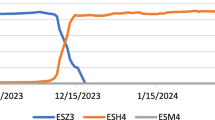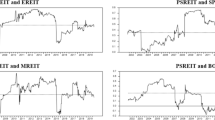Abstract
In this paper we consider the problem of deciding the portfolio of assets that should underlie an exchange-traded fund (ETF). We formulate this problem as a mixed-integer nonlinear program. We consider ETFs which have positive leverage with respect to their benchmark index and ETFs which have negative leverage (inverse, short, ETFs). Our formulation is a flexible one that incorporates decisions as to both long and short positions in assets, as well as including rebalancing and transaction cost. Computational results are given for problems, derived from universes defined by S&P international equity indices, involving up to 1,200 assets.

Similar content being viewed by others
References
Alexander, C., Barbosa, A.: Hedging index exchange traded funds. J. Bank. Finance 32(2), 326–337 (2008)
Avellaneda, M., Zhang, S.: Path-dependence of leveraged ETF returns. SIAM J. Financ. Math. 1(1), 568–603 (2010)
Beasley, J.E.: Portfolio optimisation: models and solution approaches. In: Topaloglu, H. (Ed) Tutorials in Operations Research, vol. 10, chapter 11, pp. 201–221. INFORMS, Catonsville, Maryland, USA (2013)
Beasley, J.E., Meade, N., Chang, T.-J.: An evolutionary heuristic for the index tracking problem. Eur. J. Oper. Res. 148(3), 621–643 (2003)
Boehmer, B., Boehmer, E.: Trading your neighbor’s ETFs: competition or fragmentation? J. Bank. Finance 27(9), 1667–1703 (2003)
Burer, S., Letchford, A.N.: Non-convex mixed-integer nonlinear programming: a survey. Surv. Oper. Res. Manag. Sci. 17(2), 97–106 (2012)
Bussieck, M.R., Drud, A.S., Meeraus, A.: MINLPLib—a collection of test models for mixed-integer nonlinear programming. Informs J. Comput. 15(1), 114–119 (2003)
Bussieck, M.R., Vigerske, S.: MINLP solver software. In: Cochran, J.J., Cox Jr., L.A., Keskinocak, P., Kharoufeh, J.P., Smith, J.C. (Eds.) Wiley Encyclopaedia of Operations Research and Management Science. Wiley, New York (2011). http://www2.mathematik.hu-berlin.de/~stefan/minlpsoft.pdf. Accessed 30 December 2013
Canakgoz, N.A., Beasley, J.E.: Mixed-integer programming approaches for index tracking and enhanced indexation. Eur. J. Oper. Res. 196(1), 384–399 (2009)
Chen, C., Kwon, R.H.: Robust portfolio selection for index tracking. Comput. Oper. Res. 39(4), 829–837 (2012)
Chiam, S.C., Tan, K.C., Al Mamun, A.: Dynamic index tracking via multi-objective evolutionary algorithm. Appl. Soft Comput. 13(7), 3392–3408 (2013)
Deville, L.: Exchange traded funds: history, trading, and research. In: Zopounidis, C., Doumpos, M., Pardalos, P.M. (Eds.) Handbook of Financial Engineering, Optimization and its Applications, vol. 18, pp. 67–97. Springer, New York (2008)
Garcia, F., Guijarro, F., Moya, I.: The curvature of the tracking frontier: a new criterion for the partial index tracking problem. Math. Comput. Model. 54(7–8), 1781–1784 (2011)
Gastineau, G.L.: Exchange-traded funds: an introduction. And further likely evolution. J. Portfol. Manag. 27(3), 88–96 (2001)
Giese, G.: On the risk-return profile of leveraged and inverse ETFs. J. Asset Manag. 11(4), 219–228 (2010)
Guastaroba, G., Speranza, M.G.: Kernel search: an application to the index tracking problem. Eur. J. Oper. Res. 217(1), 54–68 (2012)
Haugh, M.B.: A note on constant proportion trading strategies. Oper. Res. Lett. 39(3), 172–179 (2011)
Jarrow, R.A.: Understanding the risk of leveraged ETFs. Finance Res. Lett. 7(3), 135–139 (2010)
Kostovetsky, L.: Index mutual funds and exchange-traded funds: a comparison of two methods of passive investment. J. Portfol. Manag. 29(4), 80–92 (2003)
Kupiec, P.H.: A survey of exchange-traded basket instruments. J. Financ. Serv. Res. 4(3), 175–190 (1990)
Leyffer, S., Linderoth, J., Luedtke, J., Mahajan, A., Munson, T.: Minotaur solver. http://wiki.mcs.anl.gov/minotaur/index.php/MINOTAUR. Accessed 30 December 2013 (2013)
Mariani, M.C., Libbin, J.D., Martin, K.J., Ncheuguim, E., Varela, M.P.B., Mani, V.K., Erickson, C.A., Valles-Rosales, D.J.: Levy models and long correlations applied to the study of exchange traded funds. Int. J. Comput. Math. 86(6), 1040–1053 (2009)
Meade, N., Beasley, J.E.: Detection of momentum effects using an index out-performance strategy. Quant. Finance 11(2), 313–326 (2011)
Mezali, H., Beasley, J.E.: Quantile regression for index tracking and enhanced indexation. J. Oper. Res. Soc. 64(11), 1676–1692 (2013)
MINLPLib: http://www.gamsworld.org/minlp/minlplib.htm. Accessed 30 December 2013 (2013)
Mittelmann, H.D.: Performance of commercial and noncommercial optimization software. In: Presented at INFORMS 2012 Phoenix, Arizona. http://plato.asu.edu/talks/phoenix.pdf. Accessed 30 December 2013
Poterba, J.M., Shoven, J.B.: Exchange-traded funds: a new investment option for taxable investors. Am. Econ. Rev. 92(2), 422–427 (2002)
Roman, D., Mitra, G., Zverovich, V.: Enhanced indexation based on second-order stochastic dominance. Eur. J. Oper. Res. 228(1), 273–281 (2013)
Scozzari, A., Tardella, F., Paterlini, S., Krink, T.: Exact and heuristic approaches for the index tracking problem with UCITS constraints. Ann. Oper. Res. 205(1), 235–250 (2013)
Wang, M., Xu, C., Xu, F., Xue, H.: A mixed 0–1 LP for index tracking problem with CVar risk constraints. Ann. Oper. Res. 196(1), 591–609 (2012)
Author information
Authors and Affiliations
Corresponding author
Rights and permissions
About this article
Cite this article
Valle, C.A., Meade, N. & Beasley, J.E. An optimisation approach to constructing an exchange-traded fund. Optim Lett 9, 635–661 (2015). https://doi.org/10.1007/s11590-014-0779-x
Received:
Accepted:
Published:
Issue Date:
DOI: https://doi.org/10.1007/s11590-014-0779-x




